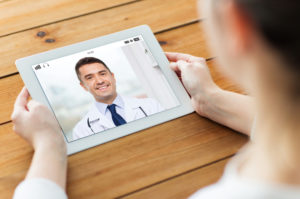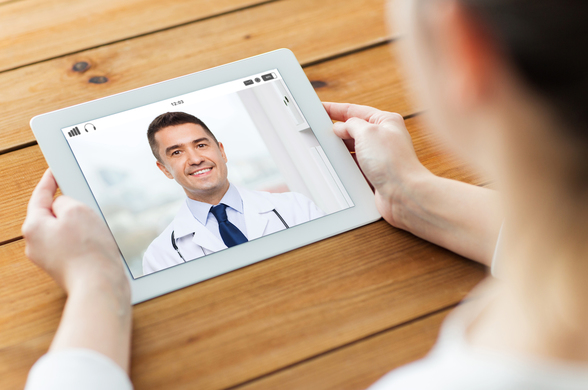 The Best of Both
The Best of Both
It’s no surprise that in today’s technology-saturated culture, there is a vast amount of research on how technology can be used within the world of medicine. However, what I did find surprising was the amount of research that included the use of artificial intelligence and robots!
So many movies ran through my brain while researching this topic. Despite my temptation to dismiss a lot of what I read off as Hollywood make-believe, I decided to read on with an open mind. After all, it wasn’t that long ago that I would have deemed it impossible for a doctor to treat my son’s spasticity through a screen on a telehealth visit, yet here we are.
Times are changing, and at lightning speed in the world of technology. While patients still desire the warmth of a real-live doctor, they also equally desire the convenience that come with technology. The best of both makes for a very special patient experience.
 Healthcare in 2020
Healthcare in 2020
To state the obvious, this year’s global pandemic has had a huge impact on advancing technology within the world of medicine.
I’ll admit, at first I did not like the changes that came with COVID-19 in regards to meeting the medical needs of my family. It was all so foreign and unfamiliar; however, I quickly realized how necessary these changes were for both my family and me.
Apparently, I wasn’t alone in this way of thinking. According to a study from Accenture, forty-four percent of 2,700 patients used new devices or apps to help manage conditions remotely during COVID-19. (1)
Although I quickly learned it’s best to leave my forty-pound son’s physical therapy to that of an in-person professional. There are certain changes that came with the pandemic that I fully adopted into our healthcare routine.
According to that same Accenture study, nine out of ten patients felt the care they received from their healthcare provider was as good or better than before COVID-19 and now sixty percent want to continue using technology more for communicating with their healthcare providers and managing their conditions. (1)
While we are not quite to the point of preferring robots over real-live humans, it’s evident the pandemic has shifted patients’ desires towards a more technologically-accessible healthcare system.
 The Balance
The Balance
There seems to be a tightrope between providing technological conveniences within healthcare, while not overwhelming the patient with technology anxiety.
It demands a delicate balance of knowing when to provide the warm touch or tone of a real human versus when to delegate certain tasks to technology.
In February of this year, Lisa Hedges authored an article titled, “The Doctor’s Office of 2030 – 4 Predictions for the Future.” (2) In her article, she discusses significant technological advancements made within the last decade and how these changes will influence the following ten years of healthcare. She specifically lists electronic medical records, the use of AI in medical chatbots, online portals, and wearable technology used to obtain real-time health information as examples of technological advancements that have improved healthcare within the last decade. Yet, she emphasizes these technological tools are ways to enhance the in-person patient-provider relationship, not replace it.
When discussing the benefits of digitally collecting a patient’s data ahead of time, she writes, “Less time spent collecting background information means the visit can be devoted solely to the patient’s current ailment or issue.” (2)
In summary, she quotes pediatrician Dr. Natasha Burgert and writes, “The key for success is for physicians to push through the learning curve and any anxiety associated with new technologies and be open to the changes that lie ahead. Physicians who maintain their willingness to listen and learn, despite the common anxiety of not knowing everything in uncharted territory, will be better positioned in the future.” (2)
 Technology AND Personal Care
Technology AND Personal Care
Patient Engagement HIT published an article in July of this year in which author Sara Heath articulates the beautiful union of technology with personal provider care.
On the heels of the necessary technological changes made as a result of the COVID-19 pandemic she writes, “Patients liked digital health technology because it was convenient while still delivering personalized care.”
She elaborates by writing, “What’s more, these digital technologies have engendered a greater sense of trust in the patient-provider relationship.” (3)
Patients have clearly adopted the new norms of technology within healthcare regarding their ability to compliment and improve the patient-provider relationship.
Accenture North America Life Sciences lead Brad Michel writes, “Companies need to invest in people, time and money now to build on this momentum to expand and enhance the tools and platforms they use to communicate with and provide care for patients. But technology is not enough, as companies must also continue to engage patients directly to deliver on expectations.” (3)
 Technological Improvements
Technological Improvements
The Medical Futurist published an article in May of 2018 in which authors include ways on how to improve a healthcare facility with the use of digital technologies. I believe these tips, coupled with the more recent technological advancements due to COVID-19, can greatly enhance the patient experience. (4)
1. Go Digital With Your Patients
The authors suggest using technology to broaden the avenues of patient communication channels such as email, text, and patient portals for non-emergent needs.
2. Try Telemedicine and Digital Devices
This is where the article dates itself in that telemedicine is now a new norm in the healthcare world. Nonetheless, I’m sure we can appreciate the authors were clearly thinking ahead.
3. Use De-stressing Tools
The article discusses the use of technology to ease the stress of physicians. From the patient’s perspective, there’s nothing more unfortunate than receiving healthcare from an overwhelmed or stressed-out physician. Likewise, I’m sure those working in the healthcare field can appreciate the author’s sentiment here. The necessity of using technology to alleviate physician stress is more necessary today than ever before.
4. Decrease Administrative Burdens With Technology
Physicians spend an alarming amount of time on administrative tasks and paper work. This article lists several tactics to “delegate” or off-load some of that workload through the use of technological devices. However, from a patient perspective, I beg of you – please do not replace a live person answering incoming calls with an automated messaging system. This is often very frustrating for patients. For more information on patients’ desires regarding phone etiquette, check out last week’s blog here.
5. Use the Hive Mind for Solving Difficult Cases
Authors suggest using a large number of people (hive mind) who share their knowledge or opinions with one another as a means to assist in rare, or difficult cases. Obviously, patient privacy would need to be maintained. Nonetheless, authors list several instances in which this tip has proven helpful in the past. (4)
 Conclusion
Conclusion
Referring back to the article published by Patient Engagement HIT, author Sara Health states it clearly in her opening sentence, “The evidence is mounting that telehealth and digital communication is here to stay, with the latest from Accenture showing 60 percent of patients will continue to access care via telehealth technology.” (3)
Successful healthcare in today’s technologically-savvy, consumer-driven world is about providing the conveniences of modern technology AND quality, personal care.
Please let us know if you have comments or questions, and subscribe to our Email Updates, so that you can be assured to receive Thinking Thursdays TIPs.
Thank you!
Jerry
Jerry L. Stone
Co-Founder/COO
MedicalGPS, LLC.
References
1 – https://www.accenture.com/us-en/insights/life-sciences/coronavirus-patient-behavior-research
2 – https://www.softwareadvice.com/resources/the-doctors-office-of-2024/
3 – https://patientengagementhit.com/news/60-of-patients-interested-in-using-digital-communication-tools
4 – https://medicalfuturist.com/how-to-imrpove-doctors-work-environment-with-tech/

